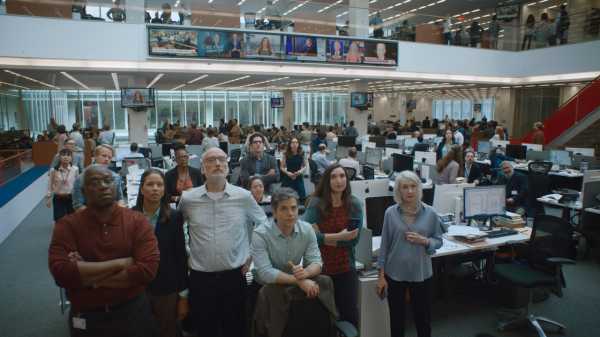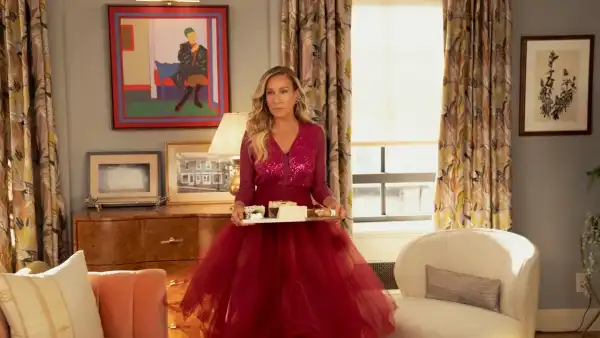
“All the President’s Men,” the ur-text of newspaper dramas, depicts a profession that looks like spycraft. The Washington Post reporters Bob Woodward and Carl Bernstein, played by Robert Redford and Dustin Hoffman, ply a trade that bristles with Cold War-era intrigue: clandestine meetings in dark parking garages, coded signals, anonymous notes concealed in deliveries. After one pivotal meeting with his background source, Woodward enters Bernstein’s apartment, wordlessly cranks the radio, and hammers out a covert message. “Deep throat says our lives may be in danger,” he types. “SURVEILLANCE BUGGING.”
It is a vision of reporting that stands in contrast to the one on view in “She Said,” a new movie that follows the New York Times investigation of Harvey Weinstein and stars Zoe Kazan and Carey Mulligan as the Pulitzer-winning reporters Jodi Kantor and Megan Twohey. (The film, directed by Maria Schrader, adapts Kantor and Twohey’s 2019 book of the same name.) If the Watergate classic made its journalist heroes look like spies, then those of the new film resemble therapists. Their work involves offering patient attention and responding with muted acknowledgments of what they have heard: the repertoire of the neutrally empathetic professional listener. As Kantor absorbs Rose McGowan’s account of her assault by Weinstein, pale curtains billow in the background. We are far from the clatter and grime of the mid-century newsroom.
This difference is surely not unrelated to the gender of the reporters in question, and the ways their respective professional triumphs are valorized. But it also has to do with the nature of the story the new movie sets out to tell. As suggested by its title (and by its poster art, a backlit female face with the superimposed question “Will you go on the record?”), “She Said” is concerned almost exclusively with the challenge of getting Weinstein’s victims to speak. “I feel like there are a lot of women who have been through something with him, but they don’t want to talk,” Kantor (played by Kazan) tells Twohey (Mulligan). “It’s hard to ask women to talk,” Twohey agrees. The problem, Kantor and Twohey quickly realize, is that internal forces like shame and fear are working in conjunction with legal settlements that have bound many women to nondisclosure agreements. The first victim Twohey finds is an ex-assistant in Queens, who says she’s been waiting twenty-five years for this conversation—and that she can’t actually have it. “All I can tell you is that I had a business dispute with Miramax,” she says, pained, her jaw clenching as she holds back tears.
The actors who portray Kantor and Twohey’s sources are good, particularly Jennifer Ehle and Samantha Morton. (Playing a former assistant who once dared to confront Weinstein, Morton conveys a prickly specificity, at once angry, weary, and shrewd.) And, as in any journalistic procedural, there is an irresistible momentum to the accretion of information; we in the audience get to watch as a story comes into being. This unfolds through a self-conscious conversational dance that’s gratifying to see performed expertly—such as when, for example, Twohey works the Weinstein ally Lanny Davis, slowly drawing him into confirming Weinstein’s many settlements with women. Woodward and Bernstein, in their onscreen incarnations, drummed up contrivances—games, almost—that allowed sources to convey information without technically saying anything. But the kind of reporting skill “She Said” depicts is more fundamental and human: a pause that entices someone to keep speaking, a willingness to let silence descend. Long stretches of the film consist of women simply describing what happened while Kantor and Twohey listen.
This focus is a strength of “She Said,” and also the movie’s great limitation. The two reporters face the challenge of getting women to speak, but, apart from that, their pursuit of the story proceeds with an odd lack of friction. Elsewhere, onscreen journalists face turf wars, skeptical colleagues, impatient bosses, institutional tensions—not Kantor and Twohey. Competition from other outlets (including this magazine) merits occasional mention, but never serious alarm. Editors (particularly Patricia Clarkson as Rebecca Corbett, in a gray bob and a series of chunky necklaces, and Andre Braugher as Dean Baquet) offer unflagging support and confidence. No one ever appears to seriously doubt the merit or magnitude of the story at hand.
And why would they? In the film’s telling, the Weinstein story came into being as an effort to replicate a past success. Early in “She Said,” Bill O’Reilly is ousted from Fox News thanks to New York Times reporting on his sexual misconduct and the network’s subsequent settlements. In the wake of this journalistic coup—serious investigative work, plus pop-culture impact—the masthead directs reporters to see what other professional arenas might provide stories of comparable misdeeds. Kantor gets a tip about Weinstein, and her editors give the go-ahead. It’s not that the movie makes her job look easy: the challenges of working motherhood, in particular, are continually emphasized (and continually managed, with the help of good-natured husbands). It’s just that there appears to be no real reason why this investigation never happened before, except perhaps that the New York Times hadn’t got around to it yet.
Twohey joins Kantor on the story after returning from maternity leave, and at first she voices a handful of reservations. Having reported on women’s accusations against Donald Trump, she wonders about the likelihood that their work will make any difference. Scanning Kantor’s roster of potential Weinstein victims, she asks about the story’s focus: “I guess my question is, like, is this the best use of our time?” Famous actresses, Twohey points out, are hardly voiceless. “If that can happen to Hollywood actresses, who else is it happening to?” Kantor counters. With that, within the world of the movie, the question is dismissed.
Still, the blinding incandescence of celebrity proves impossible to ignore. The emotional climax of the movie is the moment in which the actress Ashley Judd—played by Ashley Judd—finally agrees to go on the record. As a deadline approaches, and Kantor and Twohey scramble to get more sources to talk, we cut to a ponytailed figure in fitness gear running through yellow California hills. Back at the Times building, Kantor looks at her phone. “It’s Ashley,” she says. All go silent as she answers. The actress is calling to give them her blessing to use her name in the story. Kantor bursts into tears, ecstatic. “Ashley said yes,” Kantor tells her colleagues. “She said yes!” Judd, in California, looks beatific.
I do not discount Judd’s courage in doing what she did five years ago. But I couldn’t help noting that Kantor is somewhat less moved when, later, the former Weinstein assistant played by Ehle decides to go on the record, too, just before wheeling into the operating room for a mastectomy. It’s disconcerting to see a movie about journalism cast a gaze so reverent on a celebrity—particularly when the entanglement of journalism and Hollywood was part of this story from the beginning. The open-secret quality of the Weinstein revelations raised the immediate question of why they hadn’t been reported before. The answer had to do, at least in part, with a media ecosystem in which plenty of people beyond the movie business had an incentive to stay on Weinstein’s good side. “He played the press,” one ex-Weinstein employee tells Kantor, explaining that her former boss would shut down damaging stories with promises of celebrity access.
This information is duly noted, yet in no way borne out by anything we see onscreen. Likewise, Kantor’s reporting begins with a seemingly meaningful obstacle that vanishes instantly. “I don’t feel that inclined to talk to you,” McGowan tells her, in their first conversation. She thinks the Times (among other places) has ignored and belittled her attempts to speak out in the past. “I’m sorry that was your experience,” Kantor responds, in the even tones of a customer-service rep. What might the newspaper’s previous missteps have involved? We don’t find out, and no matter; McGowan calls her back later, unprompted, and tells her story anyway.
Maybe this is how it all happened. Given that Kantor and Twohey still work at the Times, it’s no surprise that their book would tend to portray their employer and colleagues in a diplomatic light. But, even so, the untroubled progress of “She Said” made me long for the frustrations depicted in another newspaper movie: “Spotlight.” (Or, in the idiom of that movie’s Boston old-timers, “spwotlight.”) Following a team of Boston Globe reporters investigating the coverup of sexual abuse by Catholic priests, that 2015 movie, like “She Said,” shows the simultaneous challenges of coaxing survivors to speak and chasing damning institutional documents. Editors in both films direct reporters to go after “the system.” For the purposes of “She Said,” this seems to mean the Weinstein modus operandi of abuse, bullying, and settlements. “Spotlight,” however, conveys the discomfort of recognizing that “the system” is something in which the newspaper itself participates.
By the end of “Spotlight,” Michael Keaton’s character—a Globe veteran, and the valiant leader of the Spotlight reporting team—comes to realize that not only has the story of the church’s abuse been buried in the course of many years but that he has helped bury it. He has done so not out of any conscious calculation or cartoon villainy but out of the habits and well-trodden paths of least resistance that have historically kept certain stories from getting attention. A longtime acquaintance waves off a rumor; a source seems like kind of a crank. Everyone knows how things have always worked, and all the reasons why nothing will change. Onlookers’ passivity and cynicism, not just the scheming of malefactors, have allowed predators to persist.
In the light-flooded corridors of the Times building as portrayed in “She Said,” such ambiguities are not much in evidence. (Forget the grubby cubicles and cluttered warrens that are the standard set dressing of the newspaper film; here the environment is so magnificently clean and glassy that the Times building’s architect, Renzo Piano, merits a mention in the credits.) The newspaper presented here is less a particular institution—one that might have specific flaws and foibles—than a towering, idealized fantasy of journalism incarnate. Which is too bad, because newspapers are a lot more boring that way. ♦
Sourse: newyorker.com






